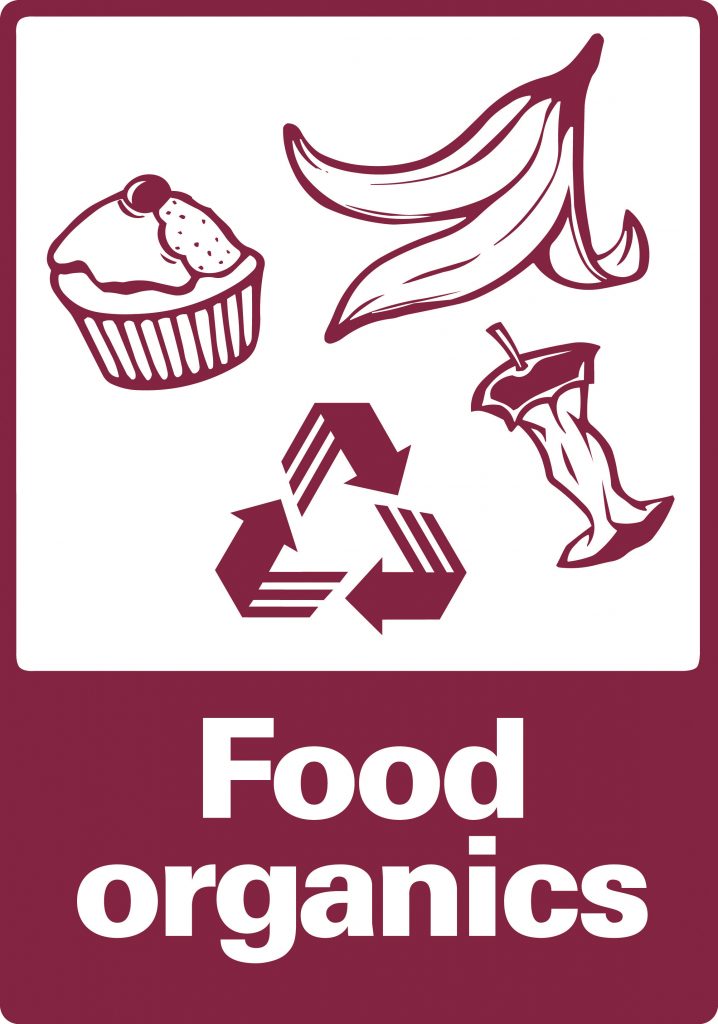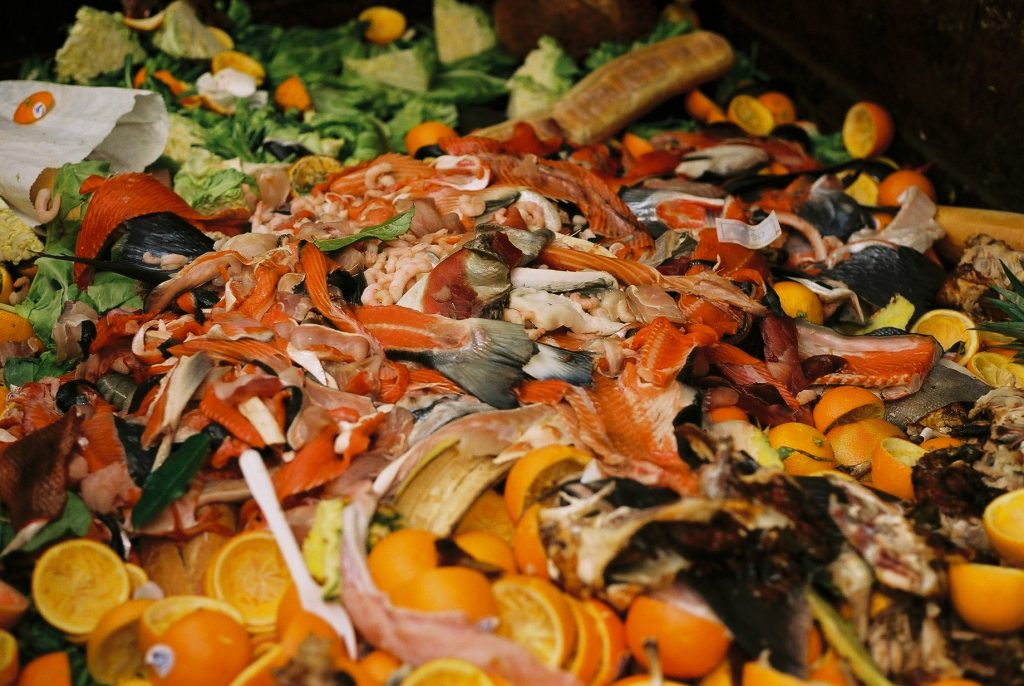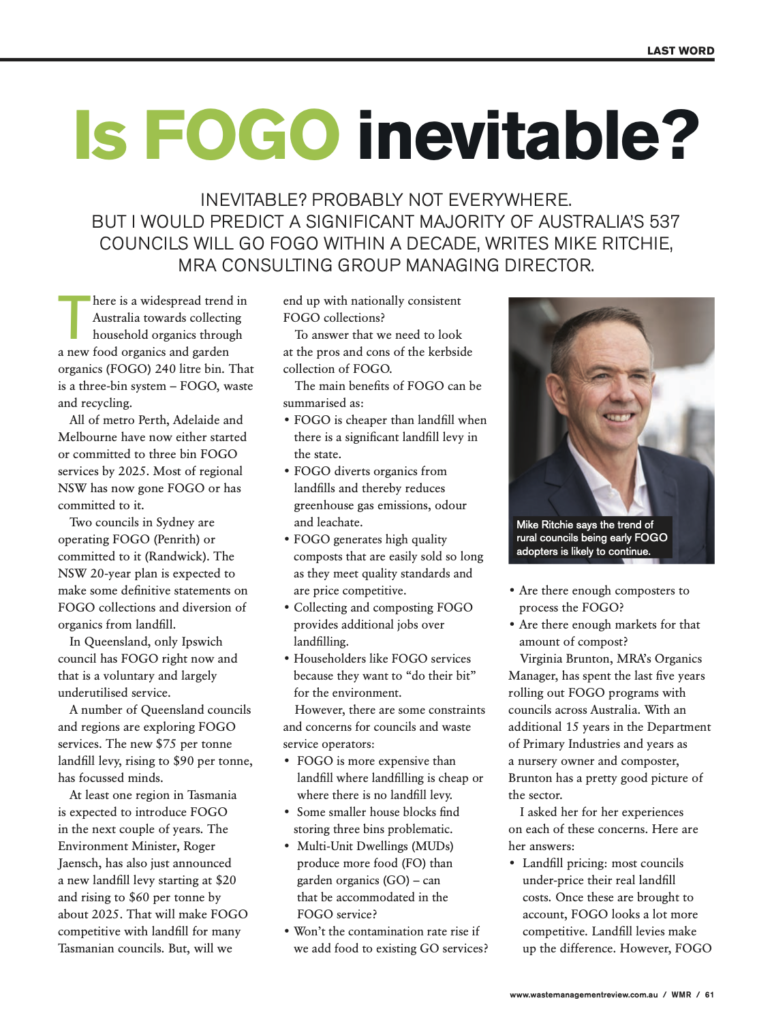Is FOGO inevitable?
By: Mike Ritchie, MRA Consulting Group

There is a widespread trend in Australia towards collecting household organics through a new FOGO (Food and Garden Organics) 240 litre bin. That is a 3-bin system (FOGO, garbage and recycling).
All of metro Perth, Adelaide and Melbourne have now either started or committed to, 3 bin FOGO services by 2025. Most of regional NSW has now gone FOGO or has committed to it.
Two councils in Sydney are operating FOGO (Penrith) or committed to it (Randwick). The NSW 20-year Plan is expected to make some definitive statements on FOGO collections and diversion of organics from landfill.
In Queensland, only Ipswich Council has FOGO right now and that is a voluntary (and largely underutilised), service. A number of Qld councils and regions are exploring FOGO services. The new $75/t landfill levy (rising to $90/t) has focussed minds.
At least one region in Tasmania is expected to introduce FOGO in the next couple of years. The Minister has also just announced a new landfill levy starting at $20 and rising to $60/t by about 2025. That will make FOGO competitive with landfill for many Tasmanian councils.
But will we end up with a nationally consistent (or at least some consistency) FOGO collections?
To answer that we need to look at the pros and cons of the kerbside collection of FOGO.
The main benefits of FOGO can be summarised as:
- FOGO is cheaper than landfill when there is a significant landfill levy in the State;
- FOGO diverts organics from landfills and thereby reduces greenhouse gas emissions, odour and leachate;
- FOGO generates high quality composts that are easily sold so long as they meet quality standards and are price competitive;
- Collecting and composting FOGO provides additional jobs over landfilling; and
- Householders like FOGO services because they want to “do their bit” for the environment.
But there are some constraints and some concerns for councils and waste service operators:
- FOGO is more expensive than landfill where landfilling is cheap or where there is no landfill levy.
- Some smaller house blocks find storing 3 bins problematic.
- Multi-Unit Dwellings (MUDs, e.g., high rise) produce more food (FO) than garden organics (GO) – can that be accommodated in the FOGO service?
- Won’t the contamination rate rise if we add food to existing GO services?
- Are there enough composters to process the FOGO?
- Are there enough markets for that amount of compost?
Virginia Brunton, MRA’s Organics Manager has spent the last 5 years rolling out FOGO programs with councils across Australia. With an additional 15 years in the Department of Primary Industries and years as a nursery owner and composter, she has a pretty good picture of the sector. I asked her for her experiences on each of these concerns. Here are her answers:
- Landfill pricing – most councils under-price their real landfill costs. Once these are brought to account FOGO looks a lot more competitive. Landfill levies make up the difference. However, FOGO can’t commercially compete with $0 landfills, ever.
- Small block sizes – Let the households that don’t want a FOGO bin or can’t fit it, to opt out of the system. So, provide it across the municipality but with mechanisms to allow for opt outs. Allow households to have larger/smaller bins or more bins depending upon demand. (Some Vic Councils will introduce a 4th glass bin so this may be a prevalent issue in urban Melbourne.)
- MUDs generate FO – True but there is more than enough GO in the system to allow for good mixing and a high quality AS4454 compliant compost. It doesn’t matter if there is a bit of extra FO from MUDs.
- Contamination – There is always a bit of extra contamination at the start of the service, but it comes down pretty quickly. Average yellow bin recycling contamination is 9-10% across Australia while average FOGO contamination is only 2%. That is important. Composters are already designing processes to remove that contamination from their final compost material. But quality matters and councils need to be on top of community education.
- Enough composters? – There are over 100 composters in Australia and enough capacity is being brought on-line to meet council needs. It is a bit of a chicken/egg story. Composters won’t build the infrastructure until they are sure a council will introduce the FOGO collection. So, looking at existing compost infrastructure is a misleading comparison. If a council goes to tender for composting infrastructure, my experience is that there will be at least half a dozen proponents wanting to build the facilities.
- Enough Markets? – Australia has more desert than just about any other country on earth. It also has the most organic matter depleted soils of any country. It is not about markets but about the price we are selling composts into those markets. I work with farmers across the country who want to use composts, but many cannot afford it compared to mineral fertilisers. So, we need to make sure we can get the compost to farmers at a competitive price. That is where landfill levies help the composter financially and that reduces the compost selling price. It creates a virtuous circle – from farm produce, to Coles/Woolies/Aldi etc, to plate, (some) to household food waste, to composter, to compost and back to the farm.
That is what one expert says, and I agree.

MRA has implemented over 40 FOGO systems now and the above is pretty much a common story. It is about engagement and communication across the supply chain from households, to councils, to industry and to farmers. Done well, it works well.
Is it inevitable? No. But the trajectory is that we will see a lot more FOGO in the years to come.
Remembering that 55% of what an average household generates in waste is FOGO waste, if we want to hit the national 80% recycling target, then we need to do a lot more FOGO (along with other initiatives).
If we want to achieve net zero emissions by 2050 (or “as soon as possible”) then we need to divert organics from landfill.
So, it is pretty much inevitable that QLD, Tasmania and Sydney will join the FOGO club. It is equally likely that the trend of rural councils being early adopters of FOGO, will continue.Inevitable? Probably not everywhere. But I would predict a significant majority of Australia’s 537 councils will go FOGO within a decade.
Mike Ritchie, is the Managing Director of MRA Consulting Group.
This article has been published by the following media outlets:




